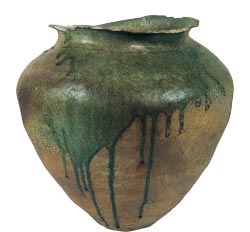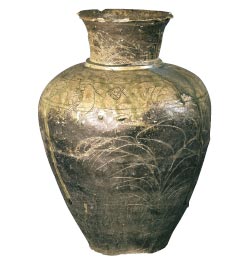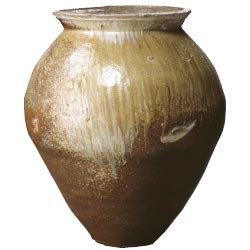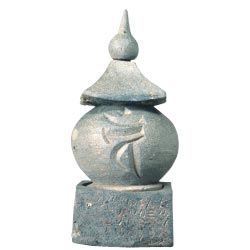
|
Tokoname
|

|
||
Boasting the largest production among medieval kilns and
greatly influencing the other unglazed ceramic production
sites throughout Japan, Tokoname played the leading role
among medieval unglazed ceramic ware. Rough and rich in
iron, its clay can be nicely fired even at low temperatures
making it suitable for the production of pots and jars. Like
the other kilns that produced unglazed pottery, its main
products consisted of pots, jars, and large bowls. From
Aomori in the north to Kyushu in the south, its pots and
jars were especially in demand across Japan as storage
vessels for fertilizers, grains, and water. The image of its
robust shape with its shoulders swelling out overlaps with
the bold appearance of the warrior, making Tokoname a leader
in medieval ceramics. With developments in agricultural
technology, perhaps such pots and jars provided support in a
time when agricultural productivity, the economic base,
rapidly rose.
|
|
Atsumi
|

|
||
The Atsumi kiln was created on the Atsumi Peninsula,
situated on the opposite shore of Chita Peninsula, where the
Tokoname kilns are located. Here, too, the three types of
vessels—pots, jars, and large bowls—were fired as primary
products. Like other kilns, it is seen as a ceramic
production site that supported agriculture.
This area also produced ceramic ware used for religious purposes such as the roof tiles for the Kamakura-period reconstruction of Tōdai-ji Temple in Nara and cylindrical jars that were often used as outer containers for sutra cases, which were buried in sutra mounds. Unlike Tokoname ware, pots with incised line drawings can be seen on Atsumi ware. A glimpse of the Atsumi potters’ aesthetic sensibility and rich creativity can be found in these pictorial decorations, such as the famous autumn grass motif (on the pot to the upper right), crossed bands, lotus petals, and heron and reeds. |
|
Echizen
|

|
||
Echizen was greatly influenced by the Tokoname kilns and
flourished in the village of Miyazaki, Nyuu County, Fukui
Prefecture, around the latter half of the 12th century. Its
main products consist of pots, jars, and large bowls, and
because Echizen developed from the introduction of
techniques from Tokoname, its forms closely resemble
Tokoname ware. The similarity of the three-ribbed pot from
the two kilns is especially notable, making it often
difficult to distinguish the two types. Since Echizen clay
is white, of better quality than Tokoname, and has a high
refractoriness, it can be fired at higher temperatures. Its
distinguishing features include tightly fired luster on its
surface and a thick heavy finish.
|
|
Suzu
|

|
||
Like
Echizen, the Suzu kilns were situated on the Japan Sea side,
in a town that was built on the tip of the Noto Peninsula in
Ishikawa Prefecture, in the 12th century. Although Suzu ware
is also unglazed, in contrast to Echizen’s reddish hue,
created in oxidation firing, the surface of Suzu ware turns
gray or black due to reduction firing. Suzu kilns inherited
the tradition of Sue ware that was brought to Japan from the
Korean Peninsula during the Kofun period (250−538), and its
main products—also pots, jars, and large bowls—were created
using the paddling (J., tataki) technique. A unique
aesthetic sensibility—such as the decorative elements of
zigzag patterns created by paddling, trees, and crossed
bands, as well as lugs—can be seen in Suzu ware. Religious
works, such as this five-tiered stupa (on the right), also
can be found.
|